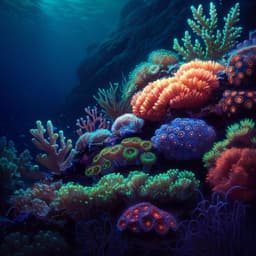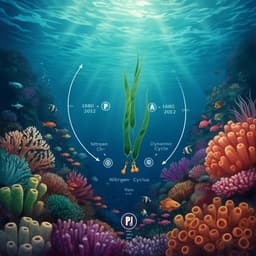
Environmental Studies and Forestry
Vulnerability to collapse of coral reef ecosystems in the Western Indian Ocean
D. Obura, M. Gudka, et al.
This groundbreaking study explores the alarming vulnerability of coral reef ecosystems in the Western Indian Ocean to collapse, highlighting the critical impacts of climate change and fishing pressures. The research conducted by David Obura and colleagues calls for urgent ecosystem-based management and climate action to preserve these vital environments.
~3 min • Beginner • English
Introduction
The paper addresses the growing risk of ecosystem collapse in the Anthropocene, focusing on coral reefs in the Western Indian Ocean. It highlights that coral reefs, among the most biodiverse and valuable ecosystems, face cumulative local (fishing, pollution, disease, cyclones) and global (warming, acidification) stressors with evidence of substantial recent degradation and a limited window before potential collapse. Traditional reliance on live coral cover as a sole indicator is insufficient to capture ecological integrity, composition, and function. The study adopts the IUCN Red List of Ecosystems (RLE) framework to provide a standardized, multi-criteria assessment of collapse risk, integrating changes in extent, abiotic degradation, and biotic disruption. The objective is to assess regional and ecoregional collapse risk, diagnose drivers, and inform policy and management coherently across scales.
Literature Review
Prior regional assessments emphasize trends in live coral cover across oceans (Indian Ocean, East Asian–West/Central Pacific, Caribbean) and shifts in coral community composition (Great Barrier Reef, WIO). However, methodological differences hinder synthesis and policy application. Calls have been made to operationalize the RLE for coral reefs by defining initial/collapsed states, drivers, and quantitative thresholds. The RLE, analogous to the Red List of Threatened Species, integrates multiple variables across five criteria to classify risk from least concern to collapsed. Studies also underline disparate resilience among regions (e.g., Caribbean vs Indo-Pacific) due to intrinsic and extrinsic factors, the need for indicators beyond coral cover to include ecosystem area and integrity, and the utility of RLE in biodiversity and sustainability policy frameworks (CBD and SDGs).
Methodology
Scope and framework: The study applied the IUCN Red List of Ecosystems (RLE) to WIO coral reefs at regional and 11 ecoregional scales, corresponding to IUCN Global Ecosystem Typology level 4 units. A conceptual coral reef ecosystem model was developed focusing on interactions among hard corals (ecosystem engineers), fleshy algae, herbivorous fishes (parrotfish; Scarini), and piscivorous fishes (groupers; Epinephelidae), and external pressures (fishing and climate warming). Data sources included the Millennium Coral Reef layer (extent), regional GCRMN datasets for coral, algae, and fish abundance, and projected SST for thermal stress.
RLE criteria and thresholds: Of five RLE criteria, A–D were assessed over a 50-year frame; E was not evaluated. Criterion A (reduction in geographic distribution) used a proxy for functioning reef extent: proportion of sites with coral cover ≤10% as a threshold for inadequate reef accretion and maintenance. Criterion B (restricted distribution) used extent of occurrence (EOO) and area of occupancy (AOO; number of 10×10 km grid cells with ≥1% reef) derived from the Millennium Coral Reef layer, applying subcriteria a(iii) and b where possible. Criterion C (abiotic degradation) assessed future thermal stress (C2a) using projected exceedances of degree heating weeks (DHW) thresholds (8 and 12 DHW) under RCP2.6, 4.5, 6.0, and 8.5, with a collapse threshold of ≥2 exceedances per decade over the 50-year horizon; RCP6.0 with DHW 12 was selected as most plausible and discriminating and consistent with observed bleaching patterns. Criterion D (biotic disruption) evaluated change over 50 years (D1) for four indicators: hard coral cover, algae–coral ratio (aggregating turf, macroalgae, articulated calcareous algae), parrotfish abundance, and grouper abundance. Initial conditions (circa 50 years ago) were inferred from reference/healthy sites (pre-1998 for coral/algae; remote/protected/uninhabited for fishes) with uncertainty incorporated via random sampling repeated 750 times. Collapse thresholds: hard coral cover 5%; algae–coral ratio 0.83; parrotfish abundance 10% of initial; grouper abundance 20% of initial.
Biotic integration algorithm: To avoid overinflation of risk from a single compartment and reflect ecological hierarchies, a structured algorithm aggregated biotic risk by sequentially considering coral (root), algae, herbivores, and piscivores. If a subsequent compartment's risk exceeded the current aggregate, the overall risk was raised by one category at that step; otherwise it remained unchanged. This was tested against alternative aggregation approaches and validated against previous RLE applications (Meso-American reef, Colombian Caribbean).
Analysis: Overall risk per ecoregion followed standard RLE guidance, selecting the highest risk among A–D. Regional (whole WIO) risk was computed by area-weighting ecoregional results per criterion. Calculations were implemented in R (tidyr, dplyr, plyr, ggplot); EOO/AOO via redlistr. SST projections and reef extent were from established open datasets; biological data were compiled from contributors via GCRMN protocols.
Key Findings
Regional status: WIO coral reefs (11,919 km²; ~5% of global extent) are classified as Vulnerable (VU) to ecosystem collapse. Criteria C (abiotic degradation due to future warming; RCP6.0, DHW12) and D (biotic disruption) both returned VU, while A (recent decline in extent) and B (restricted distribution) returned Least Concern (LC). Criterion E was not evaluated.
Ecoregional variation: Among 11 ecoregions, risk ranged from Critically Endangered (CR) to VU. Seven island ecoregions exhibited highest risk driven by future warming: four CR (Comoros, Mascarene Islands, eastern Madagascar, southern Madagascar) and three EN (western Madagascar, northern Madagascar, outer Seychelles). Four ecoregions were VU: northern Tanzania–Kenya and northern Mozambique–southern Tanzania (driven by declines in piscivores indicative of fishing), northern Seychelles (A1, D1a), and Delagoa (A1, B1a(iii)b, B2, D1a, including limited distribution and decline in extent).
Drivers: Future thermal stress is the dominant regional threat, with earlier onset and higher severity for island ecoregions. Biotic disruption was primarily signaled by reduced piscivore (grouper) abundance (EN–CR in four of seven ecoregions with adequate data), consistent with fishing impacts and sensitivity to loss of coral structure. Parrotfish generally showed lower risk, and coral cover alone was LC in some areas where piscivores were EN–CR, highlighting the need for multi-compartment assessment.
Algorithm outcome: The structured biotic integration algorithm elevated overall biotic risk by at most one category per hierarchical step, preventing undue inflation from a single high-risk compartment and producing VU outcomes in cases where coral was LC but higher risk existed in algae/herbivores/piscivores.
Discussion
The study demonstrates that WIO coral reefs face a significant risk of collapse at regional and multiple ecoregional scales, predominantly due to future thermal stress compounded by fishing-induced biotic disruption. By extending beyond coral cover to include algae and key fish trophic groups, the assessment better captures ecological integrity and functional degradation relevant to collapse risk. The hierarchical aggregation algorithm provides a structured approach to integrate multi-compartment signals consistent with reef ecology, enabling more comparable and policy-relevant RLE outcomes across regions. The findings support differentiated management: island ecoregions require strong climate mitigation and adaptation planning, while continental ecoregions can achieve substantial gains by reducing local pressures (notably fishing), safeguarding connectivity nodes and climate refugia, and enhancing resilience to buy time for adaptation. The standardized framework and open workflows facilitate replication globally, positioning the RLE as a practical indicator for CBD post-2020 targets and SDG monitoring.
Conclusion
Applying the IUCN Red List of Ecosystems to WIO coral reefs, using a standardized ecosystem model and multi-criteria assessment, reveals a regional Vulnerable status with island ecoregions at highest risk from warming and continental ecoregions affected by biotic disruption from fishing. The study advances coral reef RLE practice by: integrating multiple biotic compartments alongside abiotic stress; proposing a structured biotic aggregation algorithm; aligning with global biogeographic and monitoring frameworks; and providing transparent, code-based workflows. These contributions enhance comparability across regions and strengthen decision support for climate mitigation/adaptation and ecosystem-based management. Future work should incorporate finer taxonomic/functional coral data, disaggregate algal and fish functional groups, include additional compartments (e.g., urchins, invertebrates), improve direct fishing pressure metrics, extend abiotic stressors (sedimentation, eutrophication) where time series allow, and downscale assessments to national and local management scales.
Limitations
Key limitations include: incomplete temporal coverage and lack of a suitable quantitative dynamics model (criterion E not evaluated); reliance on proxies for extent (coral cover thresholds of 10% for accretion and 5% for population recovery) due to absence of direct historical extent data; limited and uneven spatial/temporal coverage for algae and fish data, necessitating aggregation of algal categories (turf and macroalgae) and use of abundance instead of biomass for fishes; absence of coral taxonomic/functional composition data, limiting detection of functional diversity loss; insufficient long-term data for sedimentation and eutrophication and uncertainty in parametrizing local collapse thresholds; climate model grid-cell variance and attenuation affecting DHW exceedance estimates and scenario interpretation; and general uncertainty in inferred baselines for 50-year comparisons. These factors may affect precision and comparability, though the multi-criteria RLE framework and uncertainty treatments mitigate some impacts.
Related Publications
Explore these studies to deepen your understanding of the subject.







